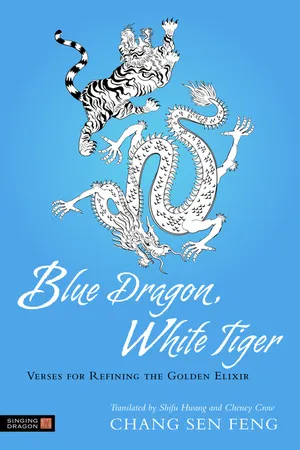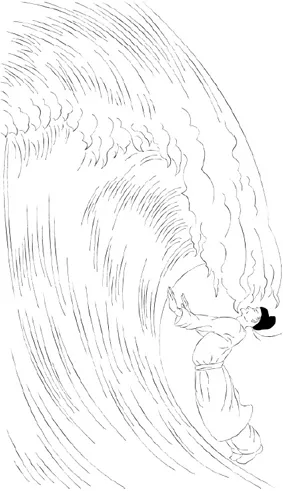![]()
Part I
![]()
CULTIVATING THE QI THROUGH SOLE BREATHING
HOW GREAT IS the mystical mother who emits the primordial Qi from her center, the bellows! The mother comes from infinite time and space (Wu Ji). How great are Yin and Yang, her successors, the two elements from which the seventh and eighth varieties can emerge! Yet, even with great striving, not all beings who seek blessing from Heaven can attain this blessing. Although immortals in Heaven and humans hold the same view of all sentient beings, the paths of humans and immortals are separate. Months and years pass by like flowing water. Sunrise and sunset exchange their scenes in the blink of an eye. The world of the dead and the world of the living are separate, alas! Winding roads are easy to follow; the straight path is hard to find. If the way of man has not been cultivated, the way of immortals will be far, far away.
The man who devotes himself to seeking the absolute Tao must strive for this. He can progress on the mystical path if he practices every day, morning and evening. He must reduce his food intake, wear loose clothing, and sit in a quiet chamber [room] holding his hands in the shape of a heart with his heels touching the Di Fu (the top of the thighs). His tongue touches the upper palate, his lips and teeth are lightly clenched. He adjusts his breath so it is gentle, as soft as cotton, and it flows through the soles of his feet. His spirit and breath enter and exit in unison. He quietly maintains control of his mind and body. His heart is calm and his outer appearance is tranquil. With all his thoughts focused on his center, all attractions are discarded. He closes the four doors of the chamber and with his mind’s eye he observes his inward body. He visualizes a pearl the size of a kernel of corn, in the Hwang Tin (Yellow Palace), in the middle Dan Tien. Then he arranges the sun of his character at the Li Wan, and the moon of the bodily essence at the Dan Fu (the Mansion of Elixirs, the middle Dan Tien). He tries to make his breath as even and as gentle as possible, he concentrates his spirit, then holds his breath for a long time. He rests in this natural ambience. Then he slowly swallows down his true Qi, and gradually sends it to his Dan Tien (lower Dan Tien). His Qi surges up from the origin of the bodily essence, follows the channel of the Du meridian, passes through the Wei Lu and rises to the Li Wan. There it arouses the origin of character and follows the channel of the Ren meridian and flows into the Min Tang (Bright Hall, the third Dan Tien) before falling into the Dan Fu. The Qi circulates like a wheel turning on the upper, middle, and lower three Dan Tiens.
In the practitioner’s back the Qi rises and in his front it moves downward. It flows this way continuously. The practitioner’s mind remains as still as clear water, and his body as transparent as a teapot made of ice. He contracts his anus, raises his bowels and breathes slowly through the soles of his feet. If the practitioner feels his breathing is too fast, he can slowly swallow down his saliva to help slow down his breath. If he feels drowsy at times, visualization techniques can be effective. He must concentrate from his first breath, gradually developing this into a hundred, then a thousand breaths. Then he can tirelessly breathe like this as many times as there are stars in the heavens. At this stage he will be able to experience the mystical effects of his training.
The practitioner must become proficient at this training first. If he cannot develop the practice of Sole Breathing, and detach himself from outside attractions, all his actions are just time wasted. Developing the difficult practice of Sole Breathing is the practitioner’s first task.
![]()
ACCUMULATING QI TO OPEN THE GATE
THIS PRACTICE BEGINS with the same initial procedure as the practice of Sole Breathing. The practitioner folds his hands and intertwines his fingers, focusing his mind at the Yu Fu (Jade Mansion, the middle Dan Tien). He concentrates on gathering his Qi, slows down all his bodily functions and enters the state of tranquility. First, he visualizes the Qi flowing in through the Yong Chuan acupoint of his left foot (Bubbling acupoint, Kidney 1). Gradually the Qi rises to his knees and thighs, and passes over the three gates, reaching the Ni Wan and then it falls slowly into the Yuan Hai (Original Sea, the lower Dan Tien). Once again, the Qi flows in through the Yong Chuan of the right foot, then rises and falls along the right side of the body. This mirrors the purpose and function of the left side.
Next, the Qi circulates four times on the right and the left sides. Then it enters through two acupoints simultaneously (right and left Yong Chuan acupoints) and circulates once more. Nine consecutive circulations make one Complete Circulation. The practitioner visualizes lifting up his bowels, slows down his Sole Breathing and does nine Complete Qi Circulations, a total of eighty-one. This practice should help the Qi circulate naturally by clearing obstructions from the gates of the meridians. If after this practice he still cannot open the gates to his meridians, the practitioner can try using the Wu Jiu (internal force, the martial artists’ Qigong) to guide his Qi circulation.
To begin the Wu Jiu, the practitioner assumes the “Lion Leaning Back” sitting posture, opens his eyes and inhales three times. The Qi will smoothly pass through the lower gate. When he feels the Qi rise to the level of his elbow, he swallows his saliva. Next he shrugs his shoulders, so the Qi will be drawn up to the Ni Wan. The practitioner completes the exercises of the Great Water Mill (Large Heaven Circulation). Then he shakes his Kun Lun (Bladder 60), rubs his abdomen for a count of eighty-one times. He rubs his head and face twenty-four times. When this is done, he pats the crown of his head three times and rotates his eyes eight times. He concentrates his mind and clenches his teeth together four or six times.
Throughout the Wu Jiu, the practitioner must raise his bowels, and control his breath. Afterwards, he must stir his saliva with his tongue and swallow one-third of it. Then he can shake his body and stand up. He shakes his body, first the left side then the right side, nine times. This sequence is called the Action technique. The practitioner can blend it with the Still technique by alternately using one, then the other. By repeating these two practices without interruption, the practitioner will have a better chance of achieving his cultivation. For the superior practitioner, it will take approximately three days and nights to open his meridians’ gates. For a middle quality practitioner it will take fourteen days to achieve this. The inferior practitioner will spend a month practicing before his gates will open. For a lazy person, this may take one hundred days. If the practitioner feels an ache in his spine, he can slow down the practice. On sunny and hot days, the practitioner may exhale and undertake the Water Mill exercise more frequently. If the practitioner is diligent in this practice, he will not suffer from any kind of sickness. He will feel wind generated in his Li Wan, and a steaming sensation in the Qi of the kidney. After experiencing this sensation, the practitioner can feel the fragrance in his Magpie Bridge (where the tongue touches the palate, in the shape of a bridge), and sweet dew drips down. If the practitioner is unable to experience this sensation, his practice must be incorrect. If he can’t open his gates with this method, how can he guide his Qi as it rises and falls? How can he cultivate his character to match his body’s essence?
![]()
CULTIVATING THE BODY’S ESSENCE WITH JADE FLUID
THE PROCEDURE FOR transforming the jade fluid into an elixir is more exciting than the last instruction. It relies on using the gold fluid to refine the ordinary lid [sexual fluids]. For this, the practitioner must learn the art of Forging the Sword, and the art of Grafting, after which he can attain an immortal lifespan of ten thousand years. To carry out this procedure, three or five trivets [consorts, maidens] must be chosen. Each of them should not be over sixteen or seventeen years old—fourteen is the best. Their appearance should be smooth, and unblemished, like a blossoming flower. They should be mature enough to produce seeds; it is inappropriate to select a trivet who has not reached puberty. The practitioner and consort remain in a quiet chamber, day and night, facing each other in a seated position. Both expose their natural forms, then proceed to strike the bamboo and raise the plumet. Next they strum the lute [masturbation], producing harmonious sounds. Each sequence is repeated three times. Gradually, the two persons’ emotions blend into union. The practitioner’s “intention to conquer” arises. However, he must not allow his desire to become a raging current. Slowly he sends his dragon to enter the cave. Lightly he holds his sword and returns it to its sheath. When the head of the turtle moves forward one inch, the practitioner must exhale, retaining about thirty to fifty percent of his breath. He draws up his bowels at this time, places his hands at his waist, shrugs his shoulders, and retracts his neck. Silently he visualizes two currents of air, red and white, rising up and slowly mounting into the great sky of the void, with which they blend and appear as the great mass of a dark wheel. It has bright luster and shines in the mystical mother.
After this moment, the practitioner closes his eyes and focuses his mind on Hwang Tin (the Yellow Palace, the middle Dan Tien). He visualizes the luster illuminating the Gate of Heaven (the crown of the head), and then tries to turn his eyes upward, toward the mystical valley. The practitioner is oblivious to the existence of his body and his partner; his emotions and the scene are both beyond his awareness. The practitioner’s sweet dew gradually forms, and drips into his Dan Tien. The body is quiet and motionless throughout the excitement, and the dew is generated. This is the body’s essence intertwined with the breath. The spirit is not yet engaged. The dragon’s intercourse with the tiger is the art of setting up the stove and the trivet. The next step of the procedure is the cooking. This is also the art of adjusting the essence of Yin and Yang. Thus the practice goes: the upper corner moon changes into the lower corner moon, and then the full moon. The practitioner performs both the Action and Tranquil techniques four times a day. Following these instructions step by step, and repeating them from the beginning to the end, he will complete the practice of Heaven Circulation. The practitioner maneuvers his Qi skillfully to circulate through his three meridian gates. The two Chis of his Yin and Yang blend into a single unit. When he reaches this level, the practitioner has completed the art of intertwining his spirit with his breath, without engaging the essence of his body. Next, he activates the bellows in harmony with his spirit. He continually fans the fire, and slowly blows into it with the bellows. He draws the wind from the bottom to the top at will. He sends in his organ with a slow exhalation, and draws it back with a strong, brief inhalation.
He fans his arms thirty-six times, then stops and remains still. Once more he dr...





